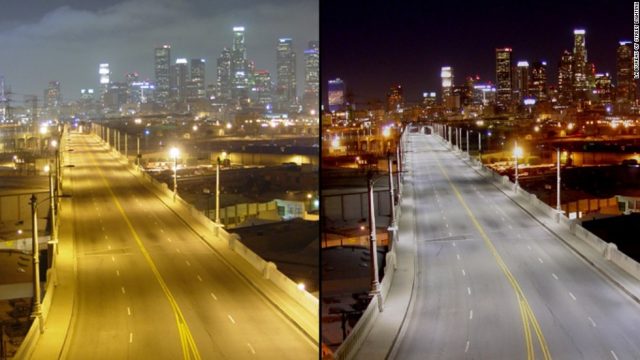Lack of natural lighting during night time in the urban environment was always a problem. From basic inconvenience that people cannot see where they are going to the greater chance of being mugged or attacked during the dark hours. Because the problem was there since humans started living together, history of street light is may be longer than we may think. An era of more efficient street light started with William Murdock in 1802, when he lit the outside of the Soho foundry in a public presentation with a gas light fuelled with coal gas. Over time, the lights were replaced with incandescent lamps that were cheaper, brighter & lasted longer, while arc lamps restricted themselves to industrial use. Later, streetlights used high-intensity discharge lamps, mostly high-pressure sodium (HPS) lamps. Over the span of decades, LEDs have transformed everything from car headlights to Christmas trees to streetlights.
But for all their advantages, LEDs have not been a perfect solution. Many high-intensity LEDs emit a large amount of blue-white light that’s been shown to decrease visual acuity & safety, creating hazardous conditions for night time driving. The harsh lighting in residential areas have been found to disrupt people’s natural sleep patterns, reduce night sky visibility & have adverse effects on nocturnal animals too. Yet, the good news is the LED has come a long way where it leads to a myriad of benefits for its users. Let’s begin from the beginning, where the journey of solar started.
INCEPTION OF LEDs
The first visible-spectrum solar LED lights was developed in 1962 by Nick H, Jr., an engineer at GE attempting to build a laser. Within a few years, it was followed by red, orange and yellow LEDs (green, violet & blue didn’t come until the 1990s). Coming up with a white LED was definitely a complex task. While it’s possible to achieve a white light by combining red, white & blue LEDs in a single enclosure, a more practical & effective method was pioneered by engineers in Japan 1997. They used a blue light that was cheapest & most efficient colour to produce because of its short wavelength.
THE RISE OF THE LED SOLAR STREETLIGHT
By the year 2008, the engineers had been able to improve the quality of white LEDs somewhat. The DOE noted that the most efficient white LEDs of the time measured 4500 to 6500k- still blue, but not as blue. This combined with remarkable energy & cost savings touted by the DOE was enough to spur cities & towns across the nation to adopt solar street lights en masse. And as was promised, many cities have reaped the savings benefits of the swap. This also led to a reduced energy usage by 70% & carbon emissions by almost 50,000 metric tons, alongside saving electricity utility bills immensely.
THE REAL COST OF LEDs
Whereas the LED technology has clearly saved municipalities a lot of money, it may have done so to the detriment of resident’s health. Now, there’s a mounting body of research demonstrating that if not properly implemented & controlled, light from LEDs can have profound negative impacts on our safety, sleep and environment. Synergy Wave System, a leasing solar EPC company in Gurgaon, earns a name of repute in the solar circuit, with an expertise of over decades and a satisfied customer base that hugely vouch for its quality service & the competitive pricing & latest in-line products. They have been a pivot in revolutionizing the solar products market in Asia & have a long-standing credible name in the industry. In the year 2016, the American Medical Association (AMA) issued a warning that blue light emitted by LED streetlights can create a glare that actually worsens night time visibility. They also warned about LED lights’ ability to suppress the melatonin & disrupt natural circadian rhythms. Research also showed that the effects weren’t confined to humans, many species of fish, birds, insects & other animals were impacted too. This research combined with the experience of living with the new lights has led citizens to express their concern over the installation of LED lights in their cities worldwide.
A BETTER WARMER LED STREETLIGHT
While some cities have chosen or been forced due to budgetary constraints to stick with their blue-white LEDs, public pressure has forced others to replace the LEDs with warmer lights. Fortunately, warmer LED streetlights are now available & they’re as efficient as their blue-white predecessors.
In recent years, lighting manufacturers have been able to achieve 3000k colour temperature without combining red & blue LEDs, taking more traditional approach to their engineering & reducing costs in the process. This improvement means warm LEDs are now a ‘no brainer’ for cities, which can enjoy benefits of the advancements.



